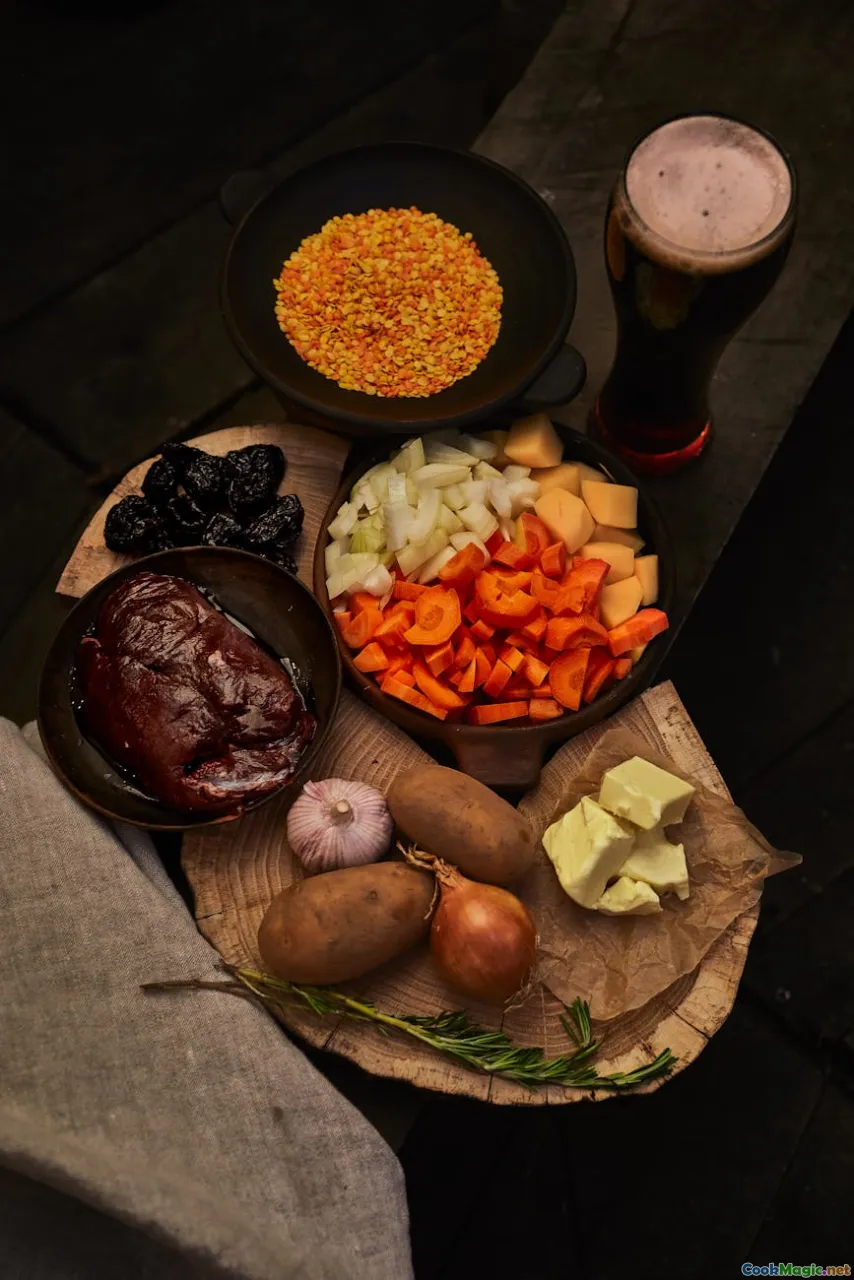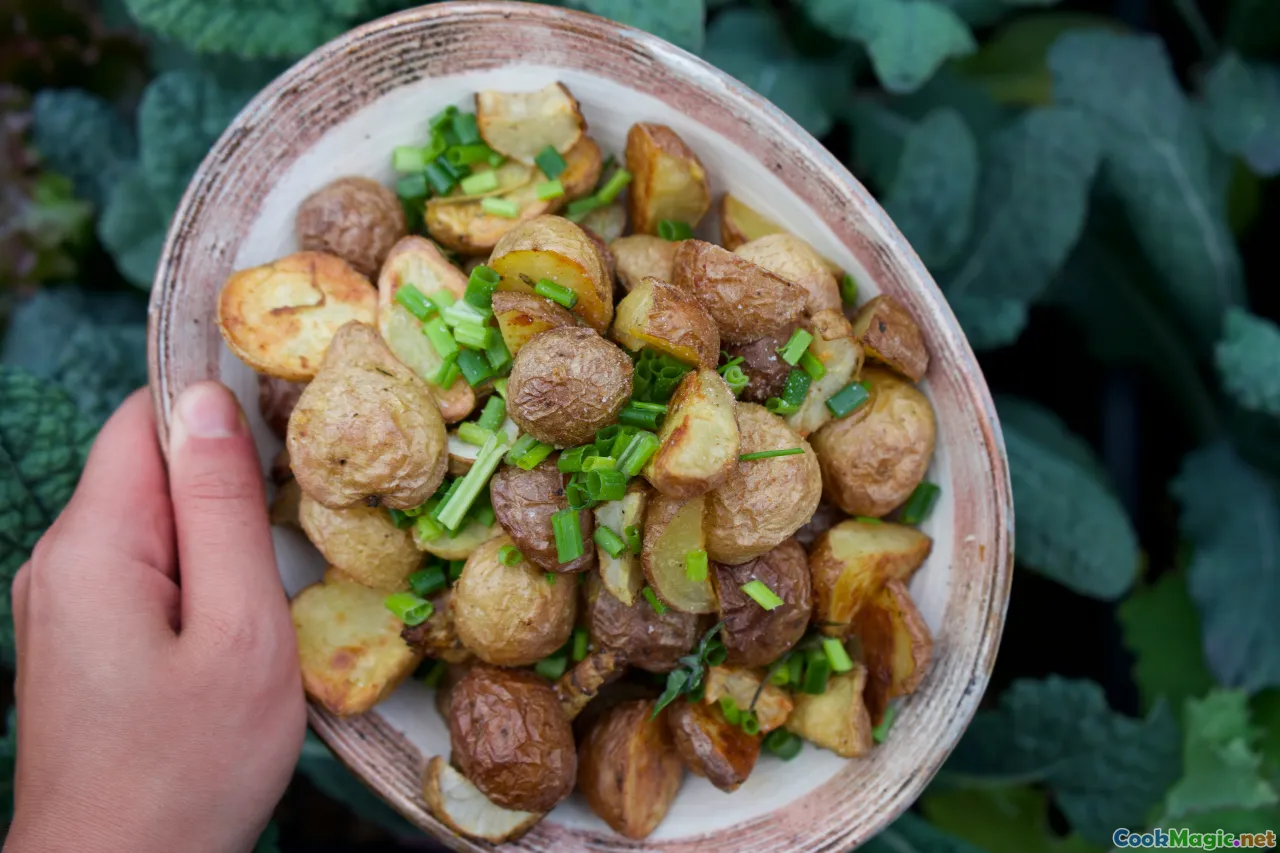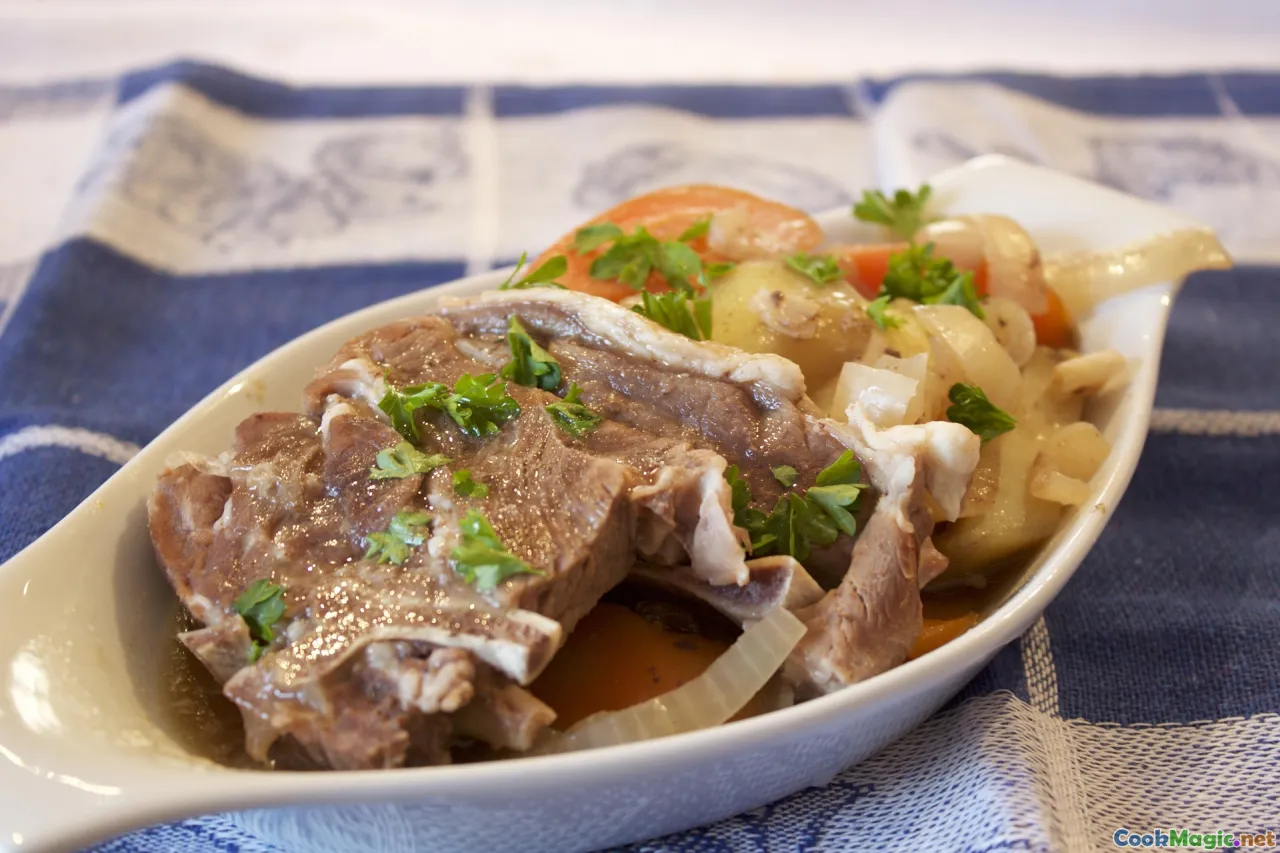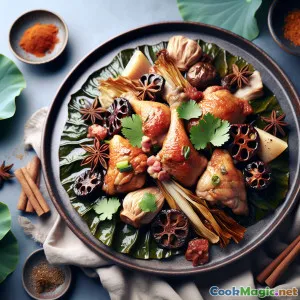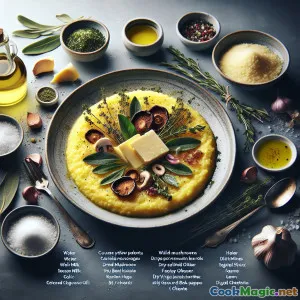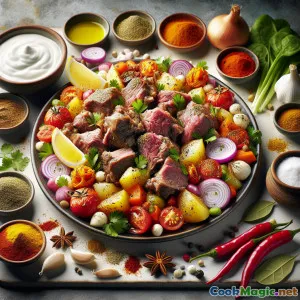
Ruandisches Lamm in würziger Kartoffelsauce
(Rwandan Lamb in Spiced Potato Sauce)
(0 Bewertungen)0
2
November 12, 2025
Problem melden
Zutaten
-
800 grams Lamb shoulder, boneless, cut into 3 cm cubes
(Trim excess surface fat but keep some for flavor and browning.)
-
100 grams Naturjoghurt
(Tenderizes during a brief marinade; omit for dairy-free.)
-
1 tbsp Zitronensaft
(Brightens the stew and helps tenderize the lamb.)
-
1.5 tsp feines Meersalz
(Adjust to taste; account for saltiness of stock.)
-
0.5 tsp Schwarzer Pfeffer, frisch gemahlen
(Adds gentle heat and depth.)
-
1 tsp Gemahlener Koriander
(Citrusy backbone of the spice blend.)
-
1 tsp Gemahlener Kreuzkümmel
(Earthy warmth; classic in East African-style blends.)
-
1 tsp Paprika (sweet)
(Color and mild sweetness; use smoked for a deeper note.)
-
0.5 tsp Kurkuma
(Golden hue and gentle bitterness.)
-
0.25 tsp Gemahlener Kardamom
(Floral lift; a nod to regional masala profiles.)
-
0.25 tsp Gemahlener Zimt
(Subtle warmth that complements lamb.)
-
2 tbsp Ghee oder neutrales Öl
(Ghee offers richer flavor; oil for a lighter finish.)
-
1 large Rote Zwiebel, in feine Scheiben geschnitten
(Caramelizes for sweetness and body in the sauce.)
-
4 cloves Knoblauch (gehackt)
(Bloom gently to avoid bitterness.)
-
20 grams Frischer Ingwer, gerieben
(Peppery freshness that balances the richness.)
-
2 medium Reife Tomaten, gehackt
(Provides acidity and natural umami.)
-
2 tbsp Tomatenmark
(Concentrated depth and color; caramelize for best flavor.)
-
1 piece Green chili (bird’s eye or similar), sliced
(Adjust for heat preference; deseed for milder stew.)
-
2 medium Karotten, gewürfelt
(Adds sweetness and texture; traditional but optional.)
-
700 grams Wachsartige Kartoffeln, geschält und in Würfel geschnitten
(Waxy varieties hold shape; floury will thicken more.)
-
2 leaves Lorbeerblätter
(Herbal backbone to the braise.)
-
600 ml Lamb or beef stock
(Low-sodium preferred; water works with extra seasoning.)
-
2 tbsp Frischer Koriander (gehackt)
(Fresh finish; parsley for a milder option.)
-
2 pieces Frühlingszwiebeln, in Scheiben geschnitten
(Green garnish for subtle bite and color.)
-
100 grams Spinach or amaranth leaves
(Stir in at the end for a nourishing finish.)
-
200 ml Wasser
(Adjust to achieve a spoon-coating sauce.)
(Trim excess surface fat but keep some for flavor and browning.)
(Tenderizes during a brief marinade; omit for dairy-free.)
(Brightens the stew and helps tenderize the lamb.)
(Adjust to taste; account for saltiness of stock.)
(Adds gentle heat and depth.)
(Citrusy backbone of the spice blend.)
(Earthy warmth; classic in East African-style blends.)
(Color and mild sweetness; use smoked for a deeper note.)
(Golden hue and gentle bitterness.)
(Floral lift; a nod to regional masala profiles.)
(Subtle warmth that complements lamb.)
(Ghee offers richer flavor; oil for a lighter finish.)
(Caramelizes for sweetness and body in the sauce.)
(Bloom gently to avoid bitterness.)
(Peppery freshness that balances the richness.)
(Provides acidity and natural umami.)
(Concentrated depth and color; caramelize for best flavor.)
(Adjust for heat preference; deseed for milder stew.)
(Adds sweetness and texture; traditional but optional.)
(Waxy varieties hold shape; floury will thicken more.)
(Herbal backbone to the braise.)
(Low-sodium preferred; water works with extra seasoning.)
(Fresh finish; parsley for a milder option.)
(Green garnish for subtle bite and color.)
(Stir in at the end for a nourishing finish.)
(Adjust to achieve a spoon-coating sauce.)
Nährwerte
- Portionen: 4
- Portionsgröße: 1 Schüssel (350g)
- Calories: 640 kcal
- Carbohydrates: 0 g
- Protein: 36 g
- Fat: 32 g
- Fiber: 7 g
- Sugar: 8 g
- Sodium: 820 mg
- Cholesterol: 110 mg
- Calcium: 95 mg
- Iron: 4.6 mg
Anweisungen
-
1 - Marinate the Lamb:
In a bowl, combine lamb with yogurt, lemon juice, 0.5 tsp salt, and black pepper. Toss to coat. Marinate while you prep other ingredients.
-
2 - Mix the potato spice blend:
Combine coriander, cumin, paprika, turmeric, cardamom, and cinnamon. This is the kirungo cy’ibirayi—the fragrant blend that defines the stew.
-
3 - Sear for deep flavor:
Heat ghee in a heavy pot over medium-high. Shake excess marinade off lamb and sear in batches until browned on two sides. Set aside.
-
4 - Soften Aromatics:
Lower heat to medium. Add onion with a pinch of salt and cook until translucent and lightly golden. Stir in garlic and ginger for 30–60 seconds.
-
5 - Bloom spices and paste:
Add tomato paste and the spice blend. Stir constantly until the paste darkens slightly and smells sweet and nutty, 60–90 seconds.
-
6 - Build the braise:
Add chopped tomatoes and chili; cook until juicy. Return lamb and any juices. Pour in stock (and water if needed) and add bay leaves. Bring to a gentle simmer.
-
7 - Simmer to Tender:
Cover and simmer on low, stirring occasionally, until lamb is just tender. Skim any excess fat if desired.
-
8 - Add potatoes and carrots:
Stir in potato chunks and carrots. Season with remaining salt. Simmer covered until potatoes are tender but not falling apart and sauce is spoon-coating.
-
9 - Finish and brighten:
Stir in spinach to wilt. Adjust salt and pepper. If desired, a squeeze more lemon heightens freshness. Remove bay leaves.
-
10 - Rest and Garnish:
Let the stew rest off heat 5 minutes. Sprinkle with cilantro and scallions before serving.
In a bowl, combine lamb with yogurt, lemon juice, 0.5 tsp salt, and black pepper. Toss to coat. Marinate while you prep other ingredients.
Combine coriander, cumin, paprika, turmeric, cardamom, and cinnamon. This is the kirungo cy’ibirayi—the fragrant blend that defines the stew.
Heat ghee in a heavy pot over medium-high. Shake excess marinade off lamb and sear in batches until browned on two sides. Set aside.
Lower heat to medium. Add onion with a pinch of salt and cook until translucent and lightly golden. Stir in garlic and ginger for 30–60 seconds.
Add tomato paste and the spice blend. Stir constantly until the paste darkens slightly and smells sweet and nutty, 60–90 seconds.
Add chopped tomatoes and chili; cook until juicy. Return lamb and any juices. Pour in stock (and water if needed) and add bay leaves. Bring to a gentle simmer.
Cover and simmer on low, stirring occasionally, until lamb is just tender. Skim any excess fat if desired.
Stir in potato chunks and carrots. Season with remaining salt. Simmer covered until potatoes are tender but not falling apart and sauce is spoon-coating.
Stir in spinach to wilt. Adjust salt and pepper. If desired, a squeeze more lemon heightens freshness. Remove bay leaves.
Let the stew rest off heat 5 minutes. Sprinkle with cilantro and scallions before serving.
Mehr über: Ruandisches Lamm in würziger Kartoffelsauce
Overview
Inyama z’Intama mu Kirungo cy’Ibirayi translates loosely to “lamb in the spice of potatoes,” a name that captures the soul of this Rwandan-inspired one-pot stew. It is rustic yet elegant, pairing tender chunks of lamb with a fragrant spice blend that complements the natural sweetness and earthiness of potatoes. This dish brings together a handful of accessible pantry spices—coriander, cumin, paprika, turmeric, and a gentle whisper of cardamom and cinnamon—bloomed in ghee to create a sauce that wraps the lamb and potatoes in warmth.
Rwanda’s highland climate is suited to tubers, and potatoes (ibirayi) are common in everyday cooking. In this interpretation, their steadying presence grounds the richer lamb, soaking up flavor while keeping their shape. The result: a balanced stew that tastes like home on a cool evening, with enough nuance to serve guests.
Ingredients Spotlight
- Lamb shoulder: Ideal for braising, with connective tissue that melts into succulence during a gentle simmer.
- Waxy potatoes: Their structure prevents disintegration. If using floury potatoes, expect a thicker, more rustic sauce as they shed starch.
- Ghee: Adds a buttery, nutty depth reminiscent of East African dairy traditions. Neutral oil works, but ghee elevates.
- Tomatoes and tomato paste: Fresh acidity plus concentrated umami ensure a full-bodied sauce.
- Kirungo (spice blend): Coriander and cumin bring warmth; paprika offers color and sweetness; turmeric paints everything gold; cardamom and cinnamon add perfumed, celebratory notes.
Technique Notes
- Searing the lamb is nonnegotiable. The caramelized crust provides a foundation of savory complexity that no amount of simmering alone can recreate.
- Bloom the spices in fat. Heating spices in ghee or oil releases fat-soluble aromatics and prevents the final stew from tasting “dusty.”
- Stage the potatoes. Add them after the lamb has begun to tenderize. This timing ensures the potatoes cook through without breaking down excessively.
- Balance the sauce. If it’s too thick, add a splash of water or stock. If it’s thin, uncover and simmer to reduce. Finish with lemon for brightness.
- Rest before serving. Five minutes off the heat allows flavors to settle and sauce to cling nicely to each bite.
Serving Suggestions
- Serve with ugali (cassava or maize meal), plain rice, or chapati to capture every drop of sauce.
- A simple side of steamed greens—amaranth leaves, sukuma wiki, or spinach—echoes the light greens stirred into the stew.
- For a homier spread, add a fresh tomato-onion salad dressed with lemon and a pinch of salt.
Make It Your Own
- Heat level: Bird’s eye chili brings a lively kick. For gentle warmth, deseed it or swap in a milder chili.
- Dairy-free: Skip the yogurt marinade. Add a teaspoon of vinegar or extra lemon juice when finishing to maintain brightness.
- Different cuts: Lamb leg works well, though it can be slightly leaner; monitor to avoid dryness and shorten the simmer if it’s already tender.
- Vegetarian interpretation: Replace lamb with hearty mushrooms and chickpeas; use vegetable stock and keep the same spice blend.
Cultural Footnotes
While Rwanda is widely known for its brochettes culture—skewers sizzling at roadside grills—home kitchens often lean on stews that stretch flavor with seasonal produce. Potatoes, grown across the northern hills, are a practical and beloved staple. The use of ghee nods to regional dairy traditions that value preserving and clarifying butter (amavuta y’inka), creating a fat with a high smoke point and a rich, layered aroma. Spicing is thoughtful rather than aggressive, allowing key ingredients—lamb and potatoes—to be the stars.
This dish borrows the spirit of a local approach: a versatile base, a measured hand with spices, and patience at the simmer. The blend here is not a strict codification but an homage to East African masalas and the gentle palates of Rwandan home cooking.
Tips & Notes
- Knife work matters: Uniform potato chunks (about 3–4 cm) cook evenly and resist breaking.
- Salt smartly: Season in layers—lightly during searing, again after adding potatoes, and once more at the end.
- Don’t rush reduction: A few extra minutes uncovered can transform a watery stew into a glossy sauce that clings.
- Next-day magic: Flavors deepen overnight. Reheat gently with a splash of water to loosen.
- Garnishes: Cilantro and scallions are optional but add welcome freshness and color.
Unique Aspects
- The “kirungo cy’ibirayi” framing centers the potato as a key flavor partner, not just a filler. Blooming the spice blend in ghee and tomato paste creates a savory paste that perfumes every element of the stew.
- Staged cooking ensures texture contrast: succulent lamb, structured potatoes, and tender greens folded in at the end.
Chef’s Thoughts
What I love most here is the balance between comfort and character. The flavors are familiar—onion, garlic, tomato—but the gentle perfume of cardamom and cinnamon sets the stew apart without overwhelming it. Each spoonful is anchored by the potato’s creamy bite, proving that simple ingredients, timed and layered with care, can feel both humble and celebratory. If you’re new to lamb, this is a welcoming gateway; if you’re a seasoned stew maker, the kirungo approach might become a new favorite in your repertoire.

